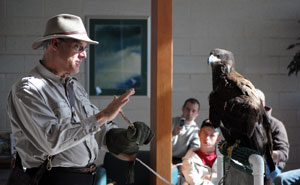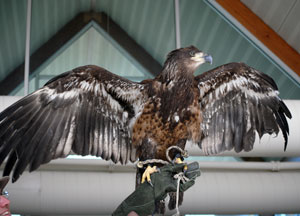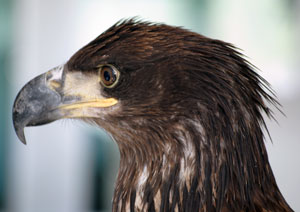Master Falconer Brings Iconic American to Wildlife Class
Published 04.20.2010
 Master falconer and licensed bald-eagle handler Michael W. Kuriga was a guest speaker for Pennsylvania College of Technology students in two sections of forest technology instructor Eric C. Easton's Wildlife Management class on Saturday, April 10.
Master falconer and licensed bald-eagle handler Michael W. Kuriga was a guest speaker for Pennsylvania College of Technology students in two sections of forest technology instructor Eric C. Easton's Wildlife Management class on Saturday, April 10.
Kuriga brought with him an immature bald eagle that suffered a dislocation in the left wing, injured after falling from its nest. He is rehabilitating the animal, which is learning to fly for short distances. Due to the nature of the injury, however, the bird never will be returned to the wild.
For nearly 30 years, Kuriga has been training and hunting with a variety of raptors. Practicing the ancient art of falconry is a passion that has taken him all over the world; he has lectured to thousands of people throughout Pennsylvania and has given talks in the United Kingdom, the Czech Republic and in many states.
 During his presentation at the Schneebeli Earth Science Center, he shared some of his adventures concerning eagles, their ecology and physiology, as well as the birds that he has flown, and stories of individuals who share his love of raptors.
During his presentation at the Schneebeli Earth Science Center, he shared some of his adventures concerning eagles, their ecology and physiology, as well as the birds that he has flown, and stories of individuals who share his love of raptors.
"The students were very interested in the presentation and they had numerous questions regarding the eagle's abilities (and) how it is trained," Easton said, "and how they, too, can become involved in the art of falconry."
In addition to the encounter with the bald eagle America's national bird students in Easton's Wildlife Management classhave experienced many of nature's creatures "up close and personal" this semester.
 They have worked with the Pennsylvania Game Commission to enhance habitat for ducks and geese. During that process, the students inspected existing man-made wood-duck nests in which they found numerous animals including screech owls, mice, squirrels and honeybees that also use the structures after the ducklings hatch and leave the nest.
They have worked with the Pennsylvania Game Commission to enhance habitat for ducks and geese. During that process, the students inspected existing man-made wood-duck nests in which they found numerous animals including screech owls, mice, squirrels and honeybees that also use the structures after the ducklings hatch and leave the nest.
During their time working with the Game Commission, students also saw a snapping turtle at one of the frozen ponds.
Other creatures have been talked about and seen, and there has been discussion of the trapping and tracking of animals. The experiences all are a part of the School of Natural Resources Management's teaching of the natural history and the environmental impact of wildlife on forests in Pennsylvania and other parts of the world.
Photos by Eric C. Easton, forestry instructor